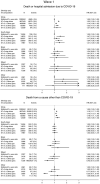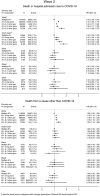Association between household composition and severe COVID-19 outcomes in older people by ethnicity: an observational cohort study using the OpenSAFELY platform
- PMID: 35962974
- PMCID: PMC9384728
- DOI: 10.1093/ije/dyac158
Association between household composition and severe COVID-19 outcomes in older people by ethnicity: an observational cohort study using the OpenSAFELY platform
Erratum in
-
Correction to: Association between household composition and severe COVID-19 outcomes in older people by ethnicity: an observational cohort study using the OpenSAFELY platform.Int J Epidemiol. 2023 Jun 6;52(3):965. doi: 10.1093/ije/dyad041. Int J Epidemiol. 2023. PMID: 37004247 Free PMC article. No abstract available.
Abstract
Background: Ethnic differences in the risk of severe COVID-19 may be linked to household composition. We quantified the association between household composition and risk of severe COVID-19 by ethnicity for older individuals.
Methods: With the approval of NHS England, we analysed ethnic differences in the association between household composition and severe COVID-19 in people aged 67 or over in England. We defined households by number of age-based generations living together, and used multivariable Cox regression stratified by location and wave of the pandemic and accounted for age, sex, comorbidities, smoking, obesity, housing density and deprivation. We included 2 692 223 people over 67 years in Wave 1 (1 February 2020-31 August 2020) and 2 731 427 in Wave 2 (1 September 2020-31 January 2021).
Results: Multigenerational living was associated with increased risk of severe COVID-19 for White and South Asian older people in both waves [e.g. Wave 2, 67+ living with three other generations vs 67+-year-olds only: White hazard ratio (HR) 1.61 95% CI 1.38-1.87, South Asian HR 1.76 95% CI 1.48-2.10], with a trend for increased risks of severe COVID-19 with increasing generations in Wave 2. There was also an increased risk of severe COVID-19 in Wave 1 associated with living alone for White (HR 1.35 95% CI 1.30-1.41), South Asian (HR 1.47 95% CI 1.18-1.84) and Other (HR 1.72 95% CI 0.99-2.97) ethnicities, an effect that persisted for White older people in Wave 2.
Conclusions: Both multigenerational living and living alone were associated with severe COVID-19 in older adults. Older South Asian people are over-represented within multigenerational households in England, especially in the most deprived settings, whereas a substantial proportion of White older people live alone. The number of generations in a household, number of occupants, ethnicity and deprivation status are important considerations in the continued roll-out of COVID-19 vaccination and targeting of interventions for future pandemics.
Keywords: COVID-19; OpenSAFELY; comorbidities; deprivation; ethnicity; household; multigenerational; older people; population-level.
© The Author(s) 2022. Published by Oxford University Press on behalf of the International Epidemiological Association.
Conflict of interest statement
None declared.
Figures



References
Publication types
MeSH terms
Substances
Grants and funding
- MR/W016729/1/MRC_/Medical Research Council/United Kingdom
- NIHR135559/DH_/Department of Health/United Kingdom
- MR/S003975/1/MRC_/Medical Research Council/United Kingdom
- MR/V038613/1/MRC_/Medical Research Council/United Kingdom
- COV-LT2-0073/DH_/Department of Health/United Kingdom
- MR/R010161/1/MRC_/Medical Research Council/United Kingdom
- 222097/Z/20/Z/WT_/Wellcome Trust/United Kingdom
- MR/V015737/1/MRC_/Medical Research Council/United Kingdom
- MC_PC_20059/MRC_/Medical Research Council/United Kingdom
- MR/V015757/1/MRC_/Medical Research Council/United Kingdom
- 220283/Z/20/Z/WT_/Wellcome Trust/United Kingdom
LinkOut - more resources
Full Text Sources
Medical

